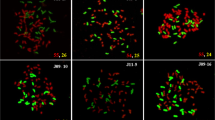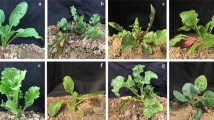Abstract
To generate drought-tolerant sugarcane, we obtained hybrid lines by the intergeneric hybridization of a Saccharum spp. hybrid with Erianthus arundinaceus. A test using 5S rDNA as a marker identified five intergeneric hybrid lines with a production efficiency of approximately 3 %. There was difficulty in maintaining these hybrid lines because they were weak, and one line only survived. We examined the amount of roots and polyphenol content of the roots, which are related to drought tolerance, in the surviving line. Although the shoot–root ratio, an indicator of the amount of roots, was high in sugarcane and low in E. arundinaceus, the shoot–root ratio of the hybrid line was intermediate between those of the parents. Regarding the polyphenol content of the roots, only the surface of a root sample was stained by NaNO3 in sugarcane, whereas the entire cross section of a root sample was stained in E. arundinaceus. For the hybrid line, the entire cross section of the root was faintly stained. From these results, we concluded that the roots characteristics were introduced by the intergeneric hybridization between a Saccharum spp. hybrid and E. arundinaceus.


Similar content being viewed by others
References
Al-Janabi SM, Forget L, Dookun A (1999) An improved and rapid protocol for the isolation of polysaccharide- and polyphenol-free sugarcane DNA. Plant Mol Biol Rep 17:1–8
Berding N, Roach BT (1987) Germplasm collection, maintenance, and use. In: Heinz DJ (ed) Sugarcane improvement through breeding. Elsevier Press, New York, pp 143–210
Bonos SA, Rush D, Hignight K, Meyer WA (2004) Selection for deep root production in tall fescue and perennial ryegrass. Crop Sci 44:1770–1775
Bors W, Heller W, Michel C, Saran M (1990) Flavonoids as antioxidants: determination of radical-scavenging efficiencies. Methods Enzymol 186:343–355
Cai Q, Aitken K, Deng HH, Chen XW, Fu C, Jackson PA, McIntyre CL (2005) Verification of the introgression of Erianthus arundinaceus germplasm into sugarcane using molecular markers. Plant Breed 124:322–328
Cheruiyot EK, Mumera LM, Ng’etich WK, Hassanali A, Wachira F (2007) Polyphenols as potential indicators for drought tolerance in tea (Camellia sinensis L.). Biosci Biotechnol Biochem 71:2190–2197
D’Hont A, Rao PS, Feldmann P, Grivet L, Islam-Faridi N, Taylor P, Glaszmann JC (1995) Identification and characterization of sugarcane intergeneric hybrids. Saccharum officinarum x Erianthus arundinaceus, with molecular markers and DNA in situ hybridization. Theor Appl Genet 91:320–326
Fazeli F, Ghorbanli M, Niknam V (2007) Effect of drought on biomass, protein content, lipid peroxidation and antioxidant enzymes in two sesame cultivars. Biol Plant 51:98–103
Hattori T, Terajima Y, Fukuhara S, Kimura T, Nishimura S, Enoki H, Matsuoka M, Sakaigaichi T, Ishikawa S, Terauchi T (2012) Improvement of breeding intergeneric hybrids between Saccharum spp. hybrid and Erianthus arundinaceus using DNA markers. Bull NARO Kyushu Okinawa Agric Res Cent. (Accepted)
Ling-Lee M, Chilvers GA, Ashford AE (1977) A histochemical study of phenolic materials in mycorrhizal and uninfected roots of Eucaluptus fastigata Deane and Maiden. New Phytol 78:313–328
Mittler R (2002) Oxidative stress, antioxidants and stress tolerance. Trends Plant Sci 7:405–410
Piperidis G, Christopher MJ, Carroll BJ, Berding N, D’Hont A (2000) Molecular contribution to selection of intergeneric hybrids between sugarcane and wild species Erianthus arundinaceus. Genome 43:1033–1037
Piperidis N, Che J, Deng H, Wang L, Jackson P, Piperidis G (2010) GISH characterization of Erianthus arundinaceus chromosome in three generations of sugarcane intergeneric hybrids. Genome 53:331–336
Rao JT, Kandasamy PA, Kumari RK (1957) Tannin in root tip as a probable genetic character of Erianthus. Curr Sci 26:219–220
Smiths DM, Inman-Bamber NG, Thornburn PJ (2005) Growth and function of the sugarcane root system. Field Crop Res 92:169–183
Acknowledgments
We are grateful to Messrs. Fukuo Hidaka, Noriaki Hirahara, Mitsumasa Kubo, Yuji Oitate, Michiaki Habu, and Setsuo Yano, NARO/KARC, for their support in conducting field experiments, Dr. Kohei Mimori, Chiyoda Science, Ltd., for FCM analysis, and Drs. Taiichiro Hattori and Takayoshi Terauchi, NARO/KARC, for critical review.
Author information
Authors and Affiliations
Corresponding author
Rights and permissions
About this article
Cite this article
Fukuhara, S., Terajima, Y., Irei, S. et al. Identification and characterization of intergeneric hybrid of commercial sugarcane (Saccharum spp. hybrid) and Erianthus arundinaceus (Retz.) Jeswiet. Euphytica 189, 321–327 (2013). https://doi.org/10.1007/s10681-012-0748-3
Received:
Accepted:
Published:
Issue Date:
DOI: https://doi.org/10.1007/s10681-012-0748-3




